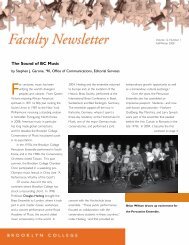Graduate Bulletin 2011–2012 - Brooklyn College - CUNY
Graduate Bulletin 2011–2012 - Brooklyn College - CUNY
Graduate Bulletin 2011–2012 - Brooklyn College - CUNY
Create successful ePaper yourself
Turn your PDF publications into a flip-book with our unique Google optimized e-Paper software.
Earth and Environmental Sciences 88<br />
hazards does New York City face? Mandatory weekend field trips<br />
within Manhattan and <strong>Brooklyn</strong>.<br />
EESC 7030T Global Environmental Change<br />
45 hours lecture; 3 credits<br />
Natural global cycles of water, carbon, nitrogen, phosphorus, and sulfur;<br />
biogeochemical changes in terrestrial ecosystems, freshwater wetlands,<br />
lakes, rivers, estuaries, and oceans; global climatic changes including<br />
global warming; anthropogenic aspects of global environmental change.<br />
EESC 7040T Geology through Global Arts and Artifacts<br />
22 ½ hours lecture, 45 hours lab; 3 credits<br />
Inquiry approach to formation and properties of minerals, rocks, and<br />
metals. Investigation of real-world applications of earth materials<br />
including those at the Metropolitan Museum of Art and other<br />
institutions in the New York City area. Laboratory work will include a<br />
minimum of 3 weekend field trips to cultural institutions.<br />
EESC 7041T New York City Water Sources and Cycles<br />
22 ½ hours lecture, 45 hours lab; 3 credits<br />
Principles of hydrology and hydrogeology with emphasis on the New<br />
York City region; history of NYC water supply; water quality; water<br />
treatment; water budgets and cycles; precipitation and storms; several<br />
weekend field trips required, including Prospect Park and Jamaica Bay.<br />
EESC 7042T Geology of New York State<br />
22 ½ hours lecture, 45 hours lab; 3 credits<br />
Field-based approach to geological history of New York State;<br />
Grenville Orogeny, Lower Paleozoic strata and the Taconic Orogeny,<br />
Catskill delta and the Acadian Orogeny, Mesozoic rift basins; 6 days of<br />
field trips across New York State, including overnights.<br />
Prerequisite: a minimum of 6 credits in Geology or Earth and<br />
Environmental Sciences.<br />
EESC 7044T Global Catastrophes<br />
22½ hours lecture, 45 hours lab<br />
Exploration of Earth dynamism and evolution; case histories of major<br />
events that changed the course of earth history such as atmospheric<br />
oxygenation, snowball Earth, Cambrian radiation, Cretaceous-Tertiary<br />
mass extinction, Central American land-bridge, and anthropogenic<br />
catastrophes; several weekend field trips required, including the<br />
American Museum of Natural History and beaches of Coney Island<br />
and/or Jamaica Bay.<br />
Prerequisites: 9 credits in Geology or Earth and Environmental<br />
Sciences.<br />
EESC 7090T Seminars in Geology<br />
3 hours lecture; 3 credits<br />
Series of seven selected topics in geology offered in public lectures in<br />
venues within New York City. Classroom-based discussion of each<br />
topic in the week following each lecture.<br />
Prerequisite: Geology or Earth and Environmental Sciences 7007T<br />
[607T] and 7008T [608T].<br />
EESC 7091T Research Experience for Teachers I:<br />
Immersion<br />
5 seminar, 40 laboratory; one and a half credits<br />
Participation in faculty-led research team; field and lab components;<br />
reflection on transferability to pre-college classroom.<br />
Prerequisite: 12 credits in earth and environmental sciences and<br />
permission of the instructor.<br />
EESC 7092T Research Experience for Teachers II: Research<br />
Proposal<br />
45 seminar; one and a half credits<br />
Seminar approach to development of research proposals; literature<br />
searches; literature reviews.<br />
Prerequisite: EESC 7091 and permission of the instructor<br />
EESC 7093T Research Experience for Teachers III:<br />
Independent Research<br />
Minimum of 9 conference and independent work; 3 credits<br />
Independent research within a faculty-supervised research team; public<br />
presentation of results required; reflection on transferability to<br />
pre-college classroom.<br />
Prerequisite: EESC 7092 and permission of the instructor.<br />
EESC 7105G Earth's Internal Processes<br />
30 hours lecture; 30 hours laboratory; 3 credits<br />
Processes driven by the Earth's internal heat. The structure,<br />
composition, and dynamics of the Earth's crust, mantle, and core; the<br />
methods and reasoning by which these have been deduced; causal<br />
mechanism for plate tectonics.<br />
EESC 7106G Earth's Surface Processes<br />
30 hours lecture; 30 hours laboratory; 3 credits<br />
Composition and dynamics of the hydrosphere and atmosphere;<br />
physical and chemical weathering; origin and evolution of land forms;<br />
human interaction with surface processes.<br />
EESC 7214G Geophysics<br />
45 hours lecture or seminar; 3 credits<br />
Principles of seismology: elastic constants, types of propagation of<br />
elastic waves. Exploration and earthquake seismology; gravity and<br />
magnetic fields of the earth. Development of a comprehensive earth<br />
model based on geophysical data and concepts.<br />
EESC 7300G Paleontology of Invertebrates<br />
30 hours lecture, 15 hours seminar, 30 hours laboratory; 4 credits<br />
Advanced treatment of the functional morphology, systematics,<br />
evolutionary history, paleoecology of invertebrate animals through<br />
geologic time. Laboratory techniques in the use of fossils as primary<br />
data of organic evolution and as indicators of paleoenvironments. (This<br />
course is also open to qualified graduate students in biology.)<br />
EESC 7400G Sedimentology<br />
30 hours lecture, 45 hours laboratory; 3 credits<br />
Dynamics of sedimentation, depositional environments, diagenesis and<br />
lithification. Fabrics, structures, classification of sedimentary rocks.<br />
Mechanical, chemical, microscopic, X-ray laboratory techniques in<br />
sedimentary analysis. Statistical methods. Special problems of clay and<br />
carbonate sedimentation.<br />
EESC 7429G Stratigraphy<br />
30 hours lecture, 30 hours laboratory; 3 credits<br />
Principles of stratigraphy. Stratigraphic record and nomenclature. Faunal<br />
stratigraphy and correlation. Systematic stratigraphy of North America:


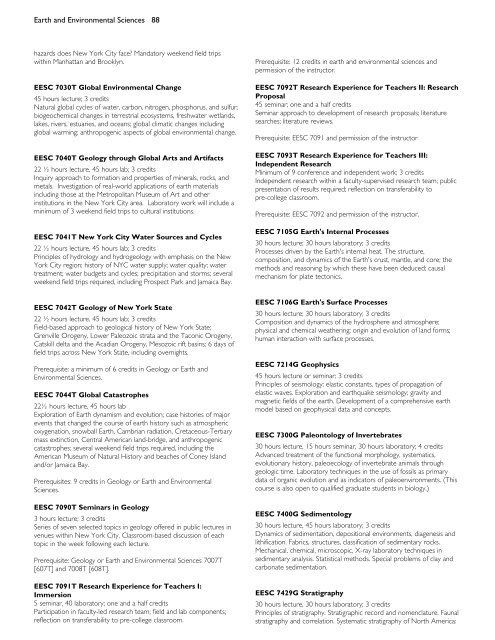
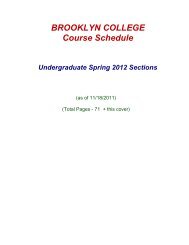


![PHIL 3314: Moral Issues in Business [Lindsay] - Brooklyn College ...](https://img.yumpu.com/12442928/1/190x245/phil-3314-moral-issues-in-business-lindsay-brooklyn-college-.jpg?quality=85)
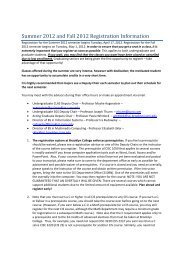

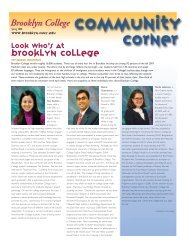

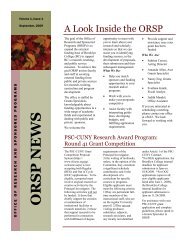
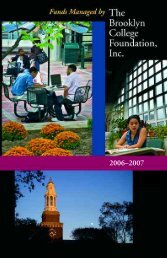
![CORC 3306: Scientific Revolutions [Menser] - Brooklyn College ...](https://img.yumpu.com/5776630/1/190x245/corc-3306-scientific-revolutions-menser-brooklyn-college-.jpg?quality=85)

![PHIL 3309: Environmental Ethics [Menser] - Brooklyn College - CUNY](https://img.yumpu.com/5776371/1/190x245/phil-3309-environmental-ethics-menser-brooklyn-college-cuny.jpg?quality=85)
